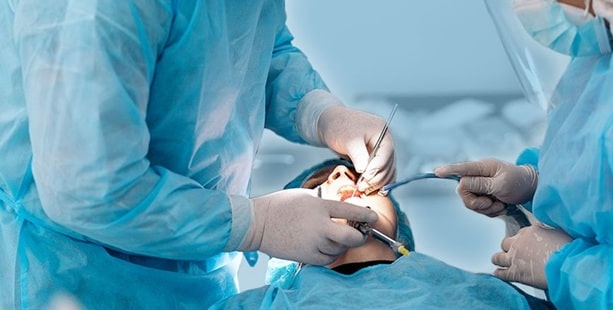Oral and Maxillofacial Surgery (OMS) is a specialized field of dentistry that focuses on the diagnosis, surgical treatment, and management of conditions affecting the mouth, jaws, face, and related structures. This branch of surgery plays a crucial role in restoring function, aesthetics, and overall quality of life for individuals facing a range of oral and facial health issues. Dr. Vivek Jaiswar, an experienced Oral and Maxillofacial Surgeon in Navi Mumbai, provides expert care at Ardent Smiles, offering advanced treatments that address complex conditions in this specialized field.
The Scope of Oral and Maxillofacial Surgery
Oral and maxillofacial surgeons are trained to handle complex cases that require a combination of surgical expertise, medical knowledge, and aesthetic consideration. The range of procedures includes everything from routine tooth extractions to intricate reconstructions of the face and jaw.

1. Complex Oral and Facial Reconstruction
Facial reconstruction often becomes necessary after trauma, surgical removal of tumors, congenital defects, or severe injuries. The goal is to restore both the appearance and the functionality of the affected areas.
Key Procedures Include:
- Bone Grafting: Rebuilding areas of the jaw using the patient’s own bone or donor material.
- Soft Tissue Reconstruction: Repairing or replacing damaged gums and other soft tissues.
- Prosthetic Rehabilitation: Designing and fitting prosthetics to replace missing facial structures.
These procedures not only improve physical appearance but also enhance the patient’s ability to speak, chew, and breathe effectively.
2. Jaw Surgery (Orthognathic Surgery)
Orthognathic surgery is designed to correct jaw irregularities, improving both function and aesthetics. This type of surgery addresses issues caused by genetic factors, developmental anomalies, or injuries.
Common Conditions Treated:
- Malocclusions (Bite Problems): Misalignments of the upper and lower jaws.
- Temporomandibular Joint (TMJ) Disorders: Pain and dysfunction in the jaw joint.
- Facial Asymmetry: Correcting uneven facial features for better balance and harmony.
Successful outcomes depend on comprehensive planning, including advanced imaging and collaboration with orthodontists.
3. Dental Implants: A Modern Solution for Missing Teeth
Dental implants have revolutionized restorative dentistry, providing a durable and natural-looking solution for missing teeth. They are anchored into the jawbone, offering stability and a more natural feel compared to traditional dentures.
Benefits of Dental Implants:
- Longevity: With proper care, implants can last a lifetime.
- Aesthetic Appeal: They mimic the appearance of natural teeth.
- Improved Functionality: Enhanced ability to chew and speak comfortably.
The process involves placing a titanium post into the jawbone, which serves as a foundation for crowns, bridges, or dentures.
4. Management of Facial Fractures
Facial fractures can result from accidents, sports injuries, or falls. Managing these fractures requires careful surgical intervention to realign bones, stabilize the affected areas, and restore both function and aesthetics.
Types of Facial Fractures:
- Jaw Fractures: Involving the mandible and maxilla.
- Orbital Fractures: Around the eye socket.
- Nasal Fractures: Breaks or injuries to the nasal bone.
Treatment often involves realigning the bones, securing them with plates or screws, and ensuring proper healing.
The Importance of a Patient-Centric Approach
A successful oral and maxillofacial surgery outcome relies on a patient-centered approach, focusing on individualized care, clear communication, and comprehensive treatment planning. This involves:
- Detailed Consultation: Understanding the patient’s medical history and treatment goals.
- Advanced Diagnostics: Using imaging technologies like 3D scans and CBCT for precise evaluation.
- Holistic Treatment Planning: Coordinating with a multidisciplinary team for the best possible results.
The Role of Technology in Oral and Maxillofacial Surgery
Technological advancements have significantly enhanced the precision and success rates of oral and maxillofacial procedures. Modern tools and techniques include:
- 3D Imaging and CBCT Scans: Providing detailed views of facial structures.
- Computer-Aided Design (CAD): Assisting in surgical planning and prosthetic creation.
- Minimally Invasive Techniques: Reducing recovery times and minimizing complications.
Recovery and Aftercare
Post-operative care is crucial for ensuring proper healing and minimizing complications. Recovery timelines vary depending on the procedure, but key aspects include:
- Pain Management: Using prescribed medications effectively.
- Dietary Guidelines: Recommending soft foods and avoiding strenuous activities.
- Follow-Up Appointments: Monitoring progress and addressing any post-surgical concerns.
Conclusion: The Lasting Impact of Oral and Maxillofacial Surgery
Oral and maxillofacial surgery is more than just a medical procedure; it’s a transformative journey that restores confidence, enhances functionality, and improves overall quality of life. Surgeons like Dr. Vivek Jaiswar at Ardent Smiles in Navi Mumbai exemplify the blend of art and science in this specialized field, offering patients the opportunity to reclaim their smiles and well-being.
Whether it’s correcting jaw misalignments, restoring facial fractures, or replacing missing teeth with dental implants, oral and maxillofacial surgery continues to make a profound difference in the lives of many.

